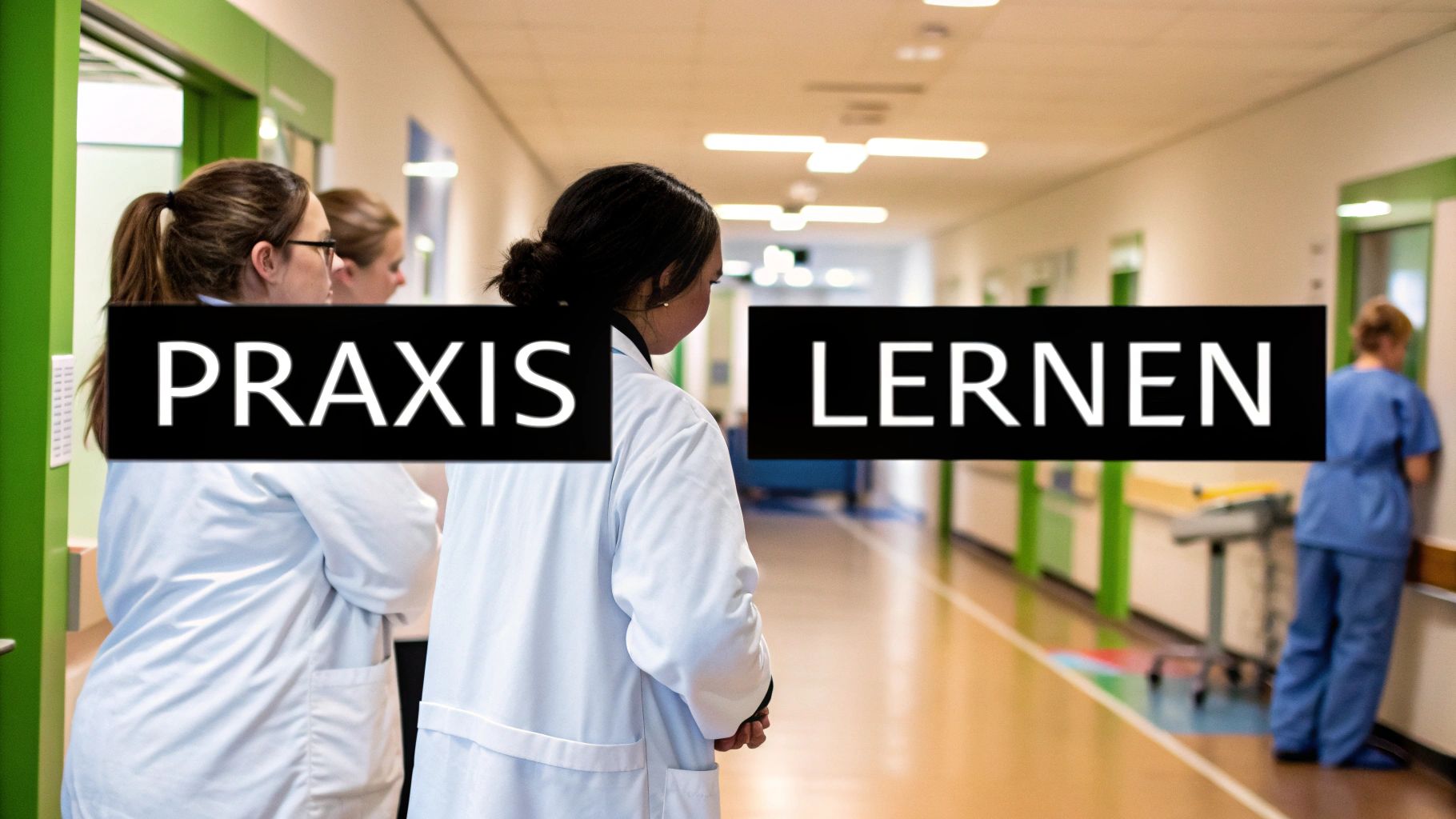The Path to Medical School: More Than Just a Good NC

The dream of medical school: For many, it begins with a look at the Numerus Clausus (NC). A good NC is important, no question. But it's not everything. There are various ways to get a place to study human medicine. In addition to the NC, other factors also play a role.
Alternative Paths to a University Place
The top high school graduates quota is not the only way into medical school. Through the AdH process (university selection process) , universities can select candidates according to individual criteria. Motivation, personal strengths, and practical experience often play a major role here. Many universities conduct interviewsto better assess the suitability of applicants. The Medical Test (TMS) assesses cognitive performance and study interest.
Good preparation is half the battle
Good preparation increases your chances of securing a university place. Find out about the admission requirements of the respective university. Practical experience, for example through clinical traineeships, nursing internships, or a Voluntary Social Year (FSJ), is also important. They demonstrate your interest in the medical field and provide you with valuable insights. Also, prepare specifically for interviews. Research typical questions and practice your answers. Perhaps you will find further helpful tips here: How to master....
University places: Facts and figures
The situation regarding university places in human medicine remains tense. In the winter semester 2021/22, 38,541 people applied for 10,056 university places. The difference between the number of applicants and available places demonstrates the high level of competition. Despite rising student numbers, the number of medical graduates, relative to the population, is below the OECD average. Further statistics can be found here: Federal Statistical Office: More and more medical students. The demand for doctors in Germany therefore remains high.
Future prospects: Career after graduation
After medical school, many career paths are open to you. Inspiration for your career choice can be found, for example, in the article about Career Happiness. From the classic role as a doctor in a hospital or practice to positions in the pharmaceutical industry, healthcare management, or research, many things are possible. Careful planning and early orientation will help you find the right path.
Mastering the Preclinical Phase Without Losing Your Mind

The first semesters of medical school pose a significant challenge for many. Medical studies begin with the preclinical phase, which is characterized by an enormous amount of material and complex content. Anatomy, biochemistry, and physiology – three subjects that form the foundation for later understanding of human medicine. But how can one not only cope with this intensive phase, but also master it successfully?
Learning Strategies Beyond Rote Memorization
Simply memorizing facts is not enough in medical school. It is much more important to understand connections and apply the information. Visual learning aids, such as anatomy atlases or videos, can significantly facilitate the understanding of complex structures. Study groups offer the opportunity to learn together, support each other, and discuss the material. A good first impression in your later professional life is also important. Here are a few application writing tipsthat might be helpful.
Effective Preparation for Preparatory Courses
Preparatory courses are an important part of anatomy studies. Thorough preparation is essential here. Obtain the necessary materials early and familiarize yourself in advance with the anatomical structures . This way you can make the most of the course and deepen your knowledge.
The Clinical Connection: The Bridge to Practice
Even in the preclinical phase, it is helpful to establish the connection to clinical practice. Link the theoretical knowledge with case studies or clinical images. This makes the material more illustrative and helps to apply what has been learned later in practice.
The following table provides an overview of the most important subjects of the preclinical phase and the respective examination formats.
Overview of preclinical subjects and examinations
This table shows the most important subjects of the preclinical phase and their examination formats.
| Subject | Semester | Examination Type | Specifics |
|---|---|---|---|
| Anatomy | 1 & 2 | Written exam, oral exam | Dissection course |
| Physiology | 1 & 2 | Written exam, oral exam | Practical courses |
| Biochemistry | 1 | Written exam | Often tested in combination with Chemistry |
| Chemistry | 1 | Written exam | Often tested in combination with Biochemistry |
| Biology | 1 | Written exam | Fundamentals for many medical subjects |
In summary, the preclinical subjects of anatomy, physiology, and biochemistry (often combined with chemistry) are concluded with written exams and, in some cases, oral examinations. Internships and preparatory courses are important components of this phase.
Time Management and Mental Strategies
Good time management is essential in medical school. Create a study plan and divide the material into manageable units . Regular breaks and sufficient sleep are important to maintain concentration and performance. Especially during stressful phases, mental strategies, such as relaxation techniques or mindfulness exercises, are helpful to clear your head and deal with the pressure.
The Path to the Physikum: Step by Step
The Physikum, the first major hurdle in medical school, is fast approaching. Structured preparation is crucial here. Start learning early and review the material regularly. Practice exams help you check your learning progress and familiarize yourself with the exam format. Stay focused and believe in yourself – you can do it!
With the right learning strategies, effective time management, and the necessary mental strength, you can successfully master the preclinical phase and lay the foundation for your medical career. The path to becoming a doctor is long and demanding, but with the right preparation and support, you can achieve your goals.
From lecture hall to bedside: The clinical transformation

After the Physikum (preliminary medical examination), a new and exciting phase in medical studies begins: the clinical phase. Here, theory meets practice. The transition from textbook knowledge to actual patient care is an important and formative step on the path to becoming a physician. But how do you best master this transformation?
First steps in the clinic: Clerkships and Clinical Electives
Clerkships and clinical electives provide initial insights into everyday clinical practice. As part of the hospital team, you learn from experienced doctors and gain valuable practical experience. Use this time to develop clinical skills and apply your theoretical knowledge in practice.
- Observe: Pay close attention to the work practices of the doctors and nursing staff.
- Ask questions: Show your interest and learn from the experience of others.
- Be active: Get involved in the daily ward routine and take on tasks that are entrusted to you.
Systematically build clinical skills
The clinical phase requires new skills. Learning examination techniques and the interpretation of clinical findings are fundamental. Practice is key to success. Take every opportunity to refine your practical skills.
- Medical History: Practice patient-centered communication and targeted medical history taking.
- Physical Examination: Practice the most important examination techniques, such as auscultation, palpation, and percussion.
- Interpretation of Findings: Learn to interpret laboratory values, ECGs, and X-rays and to draw the correct diagnostic conclusions.
Bridging the Gap Between Theory and Practice: Making Clinical Connections
The clinical phase offers the ideal framework for connecting the theoretical knowledge from the preclinical semesters with practical application. By working with real patients, the relevance of the learned content becomes clear. This practical relevance strengthens understanding and motivation.
In addition, student numbers in human medicine are also developing in a gender-specific way. In the winter semester 2023/24, of 113,383 medical students, 73,244 were female and 40,139 were male. This illustrates that more and more women are choosing to study medicine. Since 2007/08, the total number of medical students has increased by over a quarter. More information on student numbers can be found here.
Preparation for Clinical Examinations
The clinical phase also includes examinations that test your practical and theoretical knowledge. Targeted preparation is crucial for exam success.
- Case studies: Analyze typical clinical pictures and practice diagnosis and treatment planning.
- Study groups: Exchange ideas with fellow students and discuss clinical cases.
- Exam simulations: Take the opportunity to participate in simulated patient presentations to test your skills under realistic conditions.
Mastering the balancing act between theory and practice
The clinical phase is demanding. The balancing act between theory and practice requires good time management and organizational skills. Prioritize your tasks and plan your study time effectively.
- Create a realistic study plan: Consider both the demands of the clinic and exam preparation.
- Use free time slots effectively: Study breaks at the clinic or on the way there can be valuable time for review.
- Pay attention to your work-life balance: Sufficient sleep, regular breaks, and social contacts are essential to meet the demands of medical school.
The clinical transformation is a crucial step in medical school. With the right preparation, commitment, and the ability to link theory and practice, you can successfully master this phase and optimally prepare for your future career as a physician.
The practical year: From student to aspiring physician

The Practical Year (PY) is an important step in medical school. It is the bridge between university studies and professional life. As a medical student during your practical year (PJ), you suddenly become part of the team and take on responsibility. This section helps you to make the most of this time.
Choosing the Right Teaching Hospital
The choice of teaching hospital significantly shapes your PJ experience. Find out about the departments and the practical opportunities. Which specializations are available? What is the level of supervision? A visit to the hospital and conversations with doctors and other PJ students will give you important insights.
Factors for a Successful Practical Year
-
Dedicated Mentors: Look for experienced doctors who will guide you and share their knowledge. A good mentor is invaluable for your career.
-
Active Participation: Get involved in the daily routine of the ward. This is how you will learn the most.
-
Regular Feedback: Talk to your supervisors and get feedback. This way you can improve.
The Elective: Your Specialization in the Practical Year
In the practical year, you can choose an elective. Take the opportunity to deepen your knowledge in an area that interests you. The elective can also be important for your later specialist choice. Blog posts on various topics related to medical studies can help you with your decision.
Practical Year Abroad: A Valuable Experience
A practical year abroad broadens your horizons. You will get to know other healthcare systems and strengthen your intercultural skills. Plan early and find out about requirements and application procedures.
Medical studies take at least six years and conclude with the state examination. After that follows the licensing examination. The specialist medical training takes another five to six years. More statistics can be found here: Development of the number of medical students.
Balancing Clinical Work and Exam Preparation
The practical year is an intensive phase. Besides clinical work, you have to study for the state examination . Good time management is important. Schedule study times and stick to them. Study groups help with learning and exchange.
Networking: Making Contacts for the Future
During the practical year, you can make contacts. Take the opportunity to network with doctors and other medical professionals. Continuing education courses and conferences broaden your knowledge and offer the opportunity to meet new people.
The practical year is challenging and rewarding at the same time. You apply your knowledge, gain experience, and prepare for your career. Use this time actively.
The final hurdle: Pass the state examination and obtain your license
The third state examination marks the completion of medical school and the beginning of your career as a physician. It is the transition from student to licensed physician. This final hurdle places high demands on preparation in order to confidently master the oral-practical examination section and convincingly demonstrate clinical skills.
Optimal preparation for the exam
The final weeks before the exam are crucial. A detailed study plan is important to manage the extensive material. Time management and prioritization are essential. Dividing the study material into manageable units and taking regular breaks helps to maintain an overview. Proven learning methods, such as flashcards or the visualization of complex relationships, can support learning.
- Focus on the main points: Concentration on exam-relevant topics and repetition of the most important content.
- Practice makes perfect: Working through past exam questions and simulating exam situations to prepare for the exam format.
- Exchange with fellow students: Study groups offer the opportunity to review the material together and help each other.
Mastering the oral-practical part
The oral-practical part of the exam requires not only theoretical knowledge but also the application of clinical skills and the examination of patients. Practice taking medical histories, performing physical examinations, and interpreting findings. Role-playing with fellow students strengthens confidence in dealing with patients. Additional information on the medical school process could be helpful.
- Project confidence: A confident demeanor and clear, structured presentation of knowledge.
- Stay calm: Even in stressful situations, calmness and concentration are important. Deep breaths and relaxation techniques help to stay calm.
- Address questions: Listen and give precise, complete answers to the examiners' questions.
From Exam to Licensure: The Path to Becoming a Physician
After passing the exam, licensurefollows, which is the state authorization to practice medicine. Timely information about the required documents and the licensure process is advisable.
- Application: Submit the application to the responsible authority.
- Required Documents: Have all documents ready, e.g., certificates, proof of identity, and health certificate.
- Processing Time: The processing time can vary. Please allow sufficient time.
First Steps in Professional Life
With the approbation, a new phase of life begins. The first steps in your professional life will shape your career. Consider which specialty and career opportunities you are aiming for.
- Hospital or Practice: Choose your preferred place of work.
- Specialist Training: Find out about the various specialties and further training opportunities.
- Networking: Build connections with other physicians and medical professionals.
The third state examination is an important milestone in medical studies. With thorough preparation, the right attitude, and a clear vision of your professional future, you will master this final hurdle and successfully launch your career as a physician.
Alternative Paths in Medical Studies: Process
You know the classic path through medical school: pre-clinical studies, clinical studies, practical year (PY), and exams. But what if this process doesn't optimally fit your life circumstances? This section highlights alternative paths that could open up new perspectives for you.
Model Study Programs: Medicine Reimagined
Model study programs often offer a different approach. For example, they place a stronger focus on research, interdisciplinary collaboration, or specialized medical disciplines.
-
Problem-Oriented Learning: Working with case studies is paramount. This directly links theory with practice.
-
Interdisciplinarity: Collaboration with other disciplines, such as engineering or computer science, is encouraged.
-
Research Orientation: The focus on research prepares you for a scientific career.
To compare the different study models, the following table is used:
Comparison of different study models in medicine
This table compares the regular study program with alternative study models in medicine
| Study Model | Special Features | Available Universities | Advantages and Disadvantages |
|---|---|---|---|
| Regular Study Program | Classic structure, focus on broad medical knowledge | Available at most universities | + Solid education, - Less flexibility |
| Model Study Programs | Focus on specific areas, innovative teaching methods | At selected universities | + Specialization, + Practical relevance, - Possibly limited career choices |
| Medical studies abroad | Different curricula, cultural exchange | Various countries | + New perspectives, - Language barriers, - Recognition in home country |
The table shows the most important differences and similarities of the various study models. Particularly noteworthy is the possibility of specialization in model study programs.
Studying Medicine Abroad: New Horizons
Studying medicine abroad, for example in Hungary, the Netherlands, or Eastern Europe, offers the opportunity to experience medicine from a different perspective. Costs, admission requirements and the recognition of the degree in your home country are important decision criteria.
-
Hungary: Popular with German students due to comparatively low tuition fees.
-
Netherlands: Selection process for international students and high language proficiency requirements.
-
Eastern Europe: Lower tuition costs, but the quality of education can vary.
Research Tracks and Doctorate: The Path to Science
Interested in research? Research tracks and doctoral programs allow you to work scientifically during your studies and advance your academic career.
Digital Learning: Study Flexibly
Online courses and digital learning platforms like Moodle offer more flexibility. However, pay attention to the quality and practical relevance of the programs. Not all digital formats are equally suitable.
Your Individual Path to a Medical Career
Choosing the right study model depends on your personal goals and circumstances. Carefully research the different options. A medical degree is always challenging, but with the right choices you can optimize your studies.
After Graduation: Career Paths Beyond the Clichés
Graduating from medical school is a significant milestone. Many immediately think of the classic career path from resident to senior physician or setting up their own practice. However, the professional world of medicine offers much more than these well-known paths. What other options are there after graduating from medical school?
Unconventional Career Paths in Medicine
Besides the traditional paths, there are numerous alternative career options for medical professionals. The pharmaceutical industry, for example, offers exciting fields of activity in research, development, and approval of new medications. Pharmaceutical Industry often also offer positions in marketing or sales. In health management, physicians can contribute their expertise in the organization and management of healthcare facilities.
The digital health industry is a growing market with great potential for innovative solutions. International organizations, such as the WHO, also offer physicians the opportunity to work globally and advocate for global health.
- Pharmaceutical Industry: Research, Development, Regulatory Affairs, Marketing
- Health Management: Hospital Management, Quality Management, Consulting
- Digital Health Industry: Telemedicine, Health Apps, Data Science
- International Organizations: WHO, Doctors Without Borders
Working Conditions and Salary Prospects
The working conditions and salary prospects in medicine vary depending on the specialization and field of activity. Work-life balance is an important factor to consider when choosing a career. Flexible working models are becoming increasingly important and allow doctors to better balance work and family life.
Career prospects for medical professionals are very good. In 2023, around 428,000 physicians were working in Germany, an increase of two percent compared to the previous year. The unemployment rate in the medical field is approximately two percent. However, there is a shortage of physicians, especially in rural areas. More statistics can be found here: Development of the number of medical students.
Concrete steps for entering alternative fields
Entering alternative fields often requires specific additional qualifications. An MBA in healthcare management can be helpful for a career in hospital management, for example. For the digital health industry, knowledge in Computer Science and Data Science is advantageous. Internships and networking offer the opportunity to make contacts and gain insights into various professional fields.
Additional Qualifications for Alternative Career Paths
| Area | Additional Qualification |
|---|---|
| Healthcare Management | MBA, Health Economics |
| Digital Health Industry | Computer Science, Data Science |
| Pharmaceutical Industry | PhD, Pharmacology |
| International Organizations | Public Health, Languages |
Work-Life Balance and Flexible Work Models
Work-life balance is an important aspect that is becoming increasingly relevant in career choices. Flexible work models, such as part-time, job sharing, or remote work, allow physicians to better balance work and family. Sabbaticals or periods of leave for research projects or voluntary work are also becoming increasingly common.
Medicine offers a broad spectrum of career opportunities – far beyond the traditional paths. Learn about the various options and find the path that best suits your interests and goals.
Are you looking for inspiring anatomy posters for your home or practice? Check out Animus Medicus ! There you will find an exclusive selection of high-quality vintage-style anatomy images.